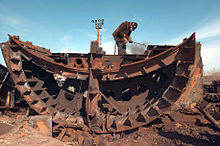
Severodvinsk
Severodvinsk (Russian: Северодви́нск; IPA: [sʲɪvʲɪrɐdˈvʲinsk]) is a city in the north of Arkhangelsk Oblast, Russia, located in the delta of the Northern Dvina, 35 kilometers (22 mi) west of Arkhangelsk, the administrative center of the oblast. As of the 2021 Census, the population was 157,213.[15] Due to the presence of important military shipyards (specialising in submarines since the Soviet period), Severodvinsk is an access-restricted town for foreign citizens. A special permit is required.[16]
This article is about the city. For the submarine class, see Yasen-class submarine.
Severodvinsk
Северодвинск
1936[4]
City Council of Deputies[5]
Igor Skubenko (since 2017)[6]
7 m (23 ft)
192,353
95th in 2010
city of oblast significance of Severodvinsk[9]
city of oblast significance of Severodvinsk[9]
Severodvinsk Urban Okrug[10]
Severodvinsk Urban Okrug[10]
+7 81842[13]
11730000001
Last Sunday of July[14]
History[edit]
Pre-20th century[edit]
Vikings explored the territories around the North Dvina River - part of Bjarmaland - at the start of the second millennium. British and Norman[4] ships came to these places for mining, fur and fishing before the 13th century, but later the climate became colder and access to the northern seas became closed.
The historical records first mention the settlement on the site of modern Severodvinsk in 1419, when the Swedes sailed into the bay and burnt down the Nikolo-Korelsky Monastery that stood by the shore during the Swedish–Novgorodian Wars. Tradition has it that Saint Euphemius, an Orthodox missionary in Karelia, founded this monastery. The abbey stood in ruins until 1471, when two sons of Marfa Boretskaya died in a vicious storm; their bodies were recovered on the beach near the monastery twelve days later. At the urging of Boretskaya, the monastery was restored and her sons were buried there.
On August 24, 1553, a ship of Richard Chancellor reached the salt-mining settlement of Nyonoksa, which is still famous for its traditional wooden architecture. The British sailors visited the Nikolo-Korelsky Monastery, where they were surprised to find a community of "sailors in soutanes (cassocks)" and a pier large enough to accommodate several ships. The main church of this extraordinary establishment was dedicated to Saint Nicholas, the holy patron of sailors; hence, the whole White Sea became known in 16th-century English maps as "St. Nicholas Bay". In late 1613, during the Time of Troubles in Russia, Polish-Lithuanian vagabonds, the Lisowczycy, captured and looted Severodvinsk with the monastery.
The Nikolo-Korelsky Monastery flourished after the establishment of the Muscovy Company, as the bulk of their trade passed through the local harbor. In August 1618 the harbour was visited by John Tradescant the elder, who conducted a survey of an island situated opposite the monastery. This island became known to the British as "Rose Island", because it was there that Tradescant found an exceedingly rare plant which he named "Rosa moscovita" (which is now known as Rosa acicularis) and brought back to London.[17]
Administrative and municipal status[edit]
Within the framework of administrative divisions, it is, together with eleven rural localities, incorporated as the city of oblast significance of Severodvinsk—an administrative unit with the status equal to that of the districts.[9] As a municipal division, the city of oblast significance of Severodvinsk is incorporated as Severodvinsk Urban Okrug.[10]
Geography[edit]
Location[edit]
The city is located near the Nikolsky mouth of the Northern Dvina at its confluence with the White Sea, 35 km northwest of Arkhangelsk, administrative centre of the region.
The area of Severodvinsk Urban Okrug, which includes the city of Severodvinsk and nearby rural settlements, is 1,193.49 square kilometres (460.81 sq mi), which is more than the area of Moscow within the MKAD. It is due to the fact that in addition to the city of Severodvinsk a large forest area with its settlements (villages and dachas) to the south and west of the city is included in the boundaries of Severodvinsk Urban Okrug itself. The area of the city within the city limits is 120.5 square kilometres (46.5 sq mi).
The city is located at a latitude of 64°34′N, which means that it is possible to observe the northern lights.
Climate[edit]
Climate in Severodvinsk is subarctic according to the Köppen climate classification. Summers are cool and winters are very cold. The average winter temperature is lower than in the central, southern and even some northern (such as Saint-Petersburg) regions of the European part of Russia. In december the Sun rises after 9 am and sets before 4 pm. But from May 17 to July 27 white nights are observed in the city.
Sport teams representing Severodvinsk in city, regional and all-Russian competitions:
Severodvinsk is twinned with:
